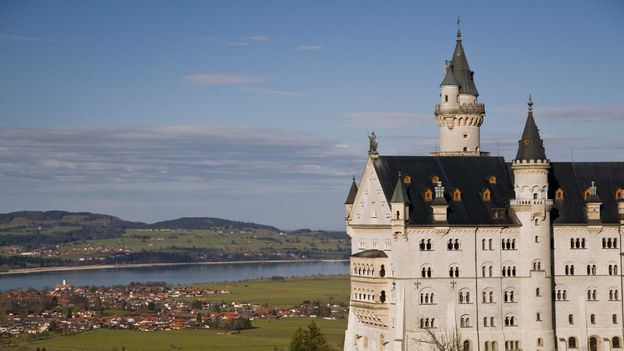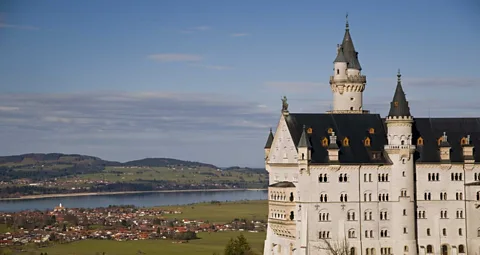Fairytale-like European castles


These grand fortresses, some in ruins, others restored to their former glory, provide a silent testament to a time long past.
Europe has thousands of years of history, full of myths and legends. Centuries may have passed, but the legacies of past rulers live on, represented by castles that were built during times of war and invasion. These grand fortresses, some in ruins , others restored to their former glory, provide a silent testament to a time long past.
Prague
Castle, Czech Republic
Calling Pražský
hrad a castle is a masterful understatement – it is really a compact walled
city, with cathedral, palaces, streets and houses. A succession of ambitious
rulers enhanced the original 9th-century fortifications, somehow blending
complementary Romanesque, Gothic, baroque and Renaissance delights. But in
truth there is one better place to be than in the castle – and that is outside
it, looking up. As the sun’s glow fades on a summer evening, or the snowflakes
drift in and out of the street lights on a chill winter’s night, few sights are
more stirring than the view from among the statues on Charles Bridge across to
the hilltop redoubt.
Explore the
thousand-year history in the Story of Prague Castle exhibition, in the Old
Royal Palace‘s Gothic vaults.
Eilean
Donan, Scotland
Brooding,
solitary, rugged… and that is just the gatekeeper. Eilean
Donan, perched atop an island on Loch Duich, is the castle that launched a
thousand Scottish tourist brochures. And why not? Just the approach will have
your mental bagpipes wheezing, clopping across the arched stone bridge
towards the grey battlements, mist drifting across the rippling water… at
least, that is how it was in the many movies filmed here, and to be fair, it is
often like that in reality. Inside, it is a fair re-creation of former glories
– the medieval castle was pulverised in 1719 by English troops, then rebuilt in
the early 20th Century.
Buses from
Inverness and Fort William stop in the village of Dornie, near the castle,
which opens March to October only.
Schloss
Neuschwanstein, Germany
Bavaria’s
“mad” King Ludwig II, the Wagner-loving royal, obsessed with romantic epics of
knightly lore, created castles of stereotypical fairytale grandeur. His
apotheosis came with Neuschwanstein,
started in 1869 atop a wooded outcrop. Witch-hatted turrets, Minstrels’ Hall,
grand throne room – all that is missing is a wicked sorcerer and perhaps a
distressed damsel incarcerated in a tower. You do not need to join the hordes
inside to appreciate Ludwig’s vision; stop at the Marienbrücke (Mary’s Bridge),
itself picturesquely spanning a waterfall in the Pöllat Gorge, for
unforgettable views of the castle.
To arrive at
the castle like a pampered prince or princess, take a horse-drawn carriage up
from nearby Hohenschwangau village.
Castell de
Púbol, Spain
If you
believe fairytales are real, perhaps you are ready for the surreal. This
medieval monument at La Pera in Catalonia, a compact Gothic-Renaissance
affair, was fascinating enough before it was bought by Salvador Dalí in 1968.
But after he installed his wife Gala here, and refurbished it to his own unique
tastes, it became something else. His trademark leftfield flourishes lurk to
wrong-foot unwary visitors. For example, Gala’s tomb in the subterranean crypt
is guarded by a stuffed giraffe. Of course. Even ignoring the oddities, it is a
charming place perched above a very strollable, traditional village.
Regular
buses between Palafrugell and Girona stop at La Pera, about 2km from the
Castell.
Tintagel,
England
Let me tell you a story about a boy who pulled a sword from a stone to become
king, aided by a wizard called Merlin… The legend of King Arthur has been so
long entwined with Tintagel Island that it was probably already in the mind of
the Earl of Cornwall when he ordered his castle
built here in 1233. Today, his stronghold is all the better for lying in ruins;
crossing the fragile-looking bridge from the mainland builds the atmosphere for
wanders among the clifftop site, where waves crash against the rocks below.
Even the screeching seagulls sound mystical here.
Palácio Nacional de Pena, Portugal
Palaces, you say? How many? In Sintra, you cannot move for tripping over
them. There is the ruined Castelo
dos Mouros overlooking the town, where another white palace dominates the
main plaza. The fantastical Quinta
da Regaleira sits amid its lush gardens; then there is Monserrate,
an exotically faux-Moorish affair. But the crown goes to pastel-turreted Palácio
Nacional da Pena. Somewhere, buried under the castellated walls of the
current 19th-century edifice, lurk the relics of a medieval convent. But you
would never know it: instead this kitsch confection of Gothic, Manueline and
Islamic styles dominates, housing an Aladdin’s cave of treasures.
Suburban line trains depart Lisbon every 15 minutes for the 45-minute run to
Sintra, making it an easy day trip from the capital.
Château de Peyrepertuse, France
As you meander along mountain roads in Languedoc-Roussillon in France’s far
southwest, hilltop fortresses loom above, some standing proud, others
snaggle-tooth ruins. Did noble knights set forth from these castles on fine
steeds to battle evil? Actually — and there is no way to break this gently —
the knights were the bad guys here. The 13th-century Albigensian Crusade saw
tens of thousands of Cathar “heretics” slaughtered – and these bastions saw the
Cathars’ last stands. The castle at Peyrepertuse, the largest and most
vertiginously sited, now hosts displays of falconry and medieval combat, but
wander to the battlements, gaze over the rugged landscape, and imagine the
lives (and deaths) of its erstwhile inhabitants.
A 195km, full-day backroads drive between Carcassonne and Perpignan visits
the four most impressive Cathar
castles.
Corvin Castle, Romania
Because sometimes fairytales are actually nightmares, Europe’s spookiest castle is,
appropriately, located on Dracula’s rumoured patch in Transylvania; some say
Vlad was imprisoned here. If you do not feel a shiver down your spine when
approaching over the bridge, with the river cascading far below, you do not
have a fear gland. It seems like the only reason there are not vampires here
today is because the werewolves ate them all. It was the stronghold of the
powerful Hungarian Corvin family in the 15th Century; more recently, Ceauşescu
spitefully built hideous steelworks alongside the castle. Even so, the ugly
neighbourhood cannot diminish the grim gravitas of the massive stone walls,
turrets and Gothic bulk.
The nearest transport hub is Deva, 18km north, from where buses make the run
of 30 to 40 minutes to Corvin Castle.
Egeskov has several museums and no fewer than four mazes – spend half a day
exploring the grounds and castle.
Malbork Castle, Poland
Bigger is not always better – but try telling that to boys. The Teutonic
Knights were clearly out to impress when they built this vast edifice,
reputedly Europe’s
largest Gothic castle. Declaring Malbork (then called Marienburg) their
capital in 1309, the knights kicked off a rush of property development,
expanding the original convent into an enormous fortification with towers, deep
moats, strong walls, an armoury and a palace for the Grand Masters. All that
did not prevent capture, first by Poles and then by Prussians, and the castle
was virtually razed during WWII. Now restored, it houses an extensive museum –
but it is the monumental building that wows.
Malbork is a 45-minute train ride from Gdańsk, itself worth exploring for
its wonderfully restored medieval centre.
Source link



